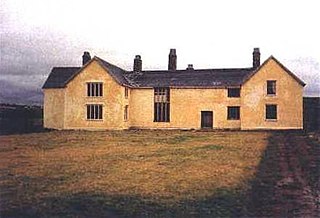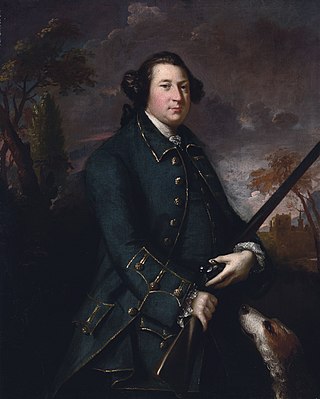

John Clotworthy, 1st Viscount Massereene (died September 1665) was a prominent Anglo-Irish politician.


John Clotworthy, 1st Viscount Massereene (died September 1665) was a prominent Anglo-Irish politician.
He was the son and heir of Sir Hugh Clotworthy (died 1630), High Sheriff of Antrim (who first came to Ireland as a soldier in the Nine Years' War), by his wife Mary Langford, daughter of Roger Langford of West Downe in the parish of Broadwoodwidger in Devon. [2]
A sculpted escutcheon showing the arms of Clotworthy impaling Langford of Kilmackedret was displayed on the facade of Antrim Castle, now demolished. [3] Sir Hugh Clotworthy was the second son of Thomas Clotworthy (born 1530) of Clotworthy [4] in the parish of Wembworthy in Devon, by his third wife Dorothy Parker, a daughter of John Parker (ancestor of the Earl of Morley (1815) [5] ) of North Molton in Devon. Sir Hugh's paternal grandmother was Ivota Rashleigh, heiress of Rashleigh [6] in Wembworthy, Devon, to which seat at some time before 1640, the senior line of the Clotworthy family eventually moved their residence from the nearby ancestral seat of Clotworthy. [7]
This section needs additional citations for verification .(December 2022) |
John was elected to the Irish House of Commons as member for County Antrim in 1634, and was a member of the Long Parliament in England, in 1640, representing Maldon. Clotworthy was a vehement opponent of Thomas Wentworth, 1st Earl of Strafford, in whose impeachment he took an active share. [8] He also took part in the prosecution of Archbishop Laud. He seems to have felt a deep personal hatred for both Strafford and Laud, springing perhaps from profound religious differences. He was criticised for his conduct at Laud's execution, where he thrust himself forward and harangued that elderly man, who was trying to prepare himself for death, on his alleged religious errors. [9]
In 1646, during the Irish Confederate Wars he unsuccessfully negotiated with the Royalist commander James Butler, 1st Duke of Ormonde for the surrender of Dublin to the Parliamentary forces. In 1647, during the English Civil War he was accused of having betrayed the Parliamentarian cause, and also of embezzlement, in consequence of which charges he fled to the Continent, but returned to parliament in June 1648.
On 12 December 1648, he was arrested and remained in prison (including at Wallingford Castle) for nearly three years. Having taken an active part in forwarding the Restoration of Charles II, he was employed in Ireland in arranging the affairs of the soldiers and other adventurers who had settled in Ireland.
Clotworthy in no way abated his old animosity against Papists and High Anglicans, despite the King's well-known leaning towards the Roman Catholic faith, and championed the cause of the Irish Presbyterians. Notwithstanding, being personally agreeable to King Charles II, his religious views were overlooked, and on 21 November 1660 he was created Baron Lough Neagh and Viscount Massereene in the Irish peerage, with the remainder in default of male heirs to his son-in-law, Sir John Skeffington.
He married Margaret Jones, daughter of Roger Jones, 1st Viscount Ranelagh and his first wife Frances Moore, by whom he had two daughters:
He died without male issue and as provided for in the special remainder, his title devolved onto his son-in-law Sir John Skeffington (husband of his daughter Mary Clotworthy), who became the 2nd Viscount Massereene and whose great-grandson, the 5th Viscount Massereene, was created Earl of Massereene in 1756. The earldom became extinct on the death of the 4th Earl without male issue in 1816, the viscounty and barony of Lough Neagh descending to his daughter Harriet Skeffington, whose husband, Thomas Foster, adopted the surname of Skeffington, and in 1824 inherited from his mother the titles of Viscount Ferrard and Baron Oriel of Collon in the Irish peerage, and from his father in 1828 that of Baron Oriel of Ferrard in the peerage of the United Kingdom.
Historians, especially Strafford's biographer Veronica Wedgwood, have dealt very harshly with Clotworthy as a human being. Wedgwood called him: "a heartless, dour and repellent man who throughout his life showed a consistent inhumanity towards his fellow men". [10] Wedgwood does however concede that, unlike others who conspired to bring Strafford down, Clotworthy was motivated less by self-interest than by genuine religious fanaticism. [11] Laud's biographer Hugh Trevor-Roper also criticises him for his unpleasant behaviour at Laud's execution, where he engaged him in religious controversy while Laud was trying to prepare himself for death. [12]
Many Clotworthys since then have emigrated to other countries around the world, many to America. There are very few known to survive in Northern Ireland.

Thomas Wentworth, 1st Earl of Strafford,, was an English statesman and a major figure in the period leading up to the English Civil War. He served in Parliament and was a supporter of King Charles I. From 1632 to 1640 he was Lord Deputy of Ireland, where he established a strong authoritarian rule. Recalled to England, he became a leading advisor to the King, attempting to strengthen the royal position against Parliament. When Parliament condemned Lord Strafford to death, Charles reluctantly signed the death warrant and Strafford was executed. He had been advanced several times in the Peerage of England during his career, being created 1st Baron Wentworth in 1628, 1st Viscount Wentworth in late 1628 or early 1629, and, finally, 1st Earl of Strafford in January 1640. He was known as Sir Thomas Wentworth, 2nd Baronet, between 1614 and 1628.

Viscount Massereene is a title in the Peerage of Ireland. It was created in 1660, along with the subsidiary title of Baron Loughneagh. From 1665 to 1816 the Skeffington Baronetcy of Fisherwick was attached to the viscountcy and from 1756 to 1816 the Viscounts also held the title of Earl of Massereene. Since 1843 the peerages are united with titles of Viscount Ferrard, of Oriel and Baron Oriel, both in the Peerage of Ireland, and Baron Oriel, in the Peerage of the United Kingdom. The Viscount also holds the subsidiary titles of Baron Loughneagh (1660) and Baron Oriel (1790) in the Peerage of Ireland and Baron Oriel (1821) in the Peerage of the United Kingdom. As Baron Oriel, he sat in the House of Lords until 1999.

John David Clotworthy Whyte-Melville Foster Skeffington, 14th Viscount Massereene and 7th Viscount Ferrard is a British peer.
John Clotworthy Talbot Foster Whyte-Melville-Skeffington, 13th Viscount Massereene and 6th Viscount Ferrard DL was a British politician and landowner. He was also Baron of Loughneagh, 6th Baron Oriel, and 6th Baron Oriel, and served as a Deputy Lieutenant for County Antrim. He succeeded his father in 1956 and regularly attended the House of Lords.

Antrim Castle or Massereene Castle was a fortified mansion in Antrim, County Antrim, Northern Ireland, on the banks of the Sixmilewater River. It was built in stages between 1613 and 1662. It was destroyed by fire in 1922 and finally demolished in the 1970s. All that remain are a slightly raised grassed platform as well as a freestanding Italian stair tower built in 1887, and a gatehouse built around 1818 with twin neo-Tudor towers, with older connecting walls. The gardens are a popular tourist attraction on the Randalstown Road, Antrim.
John Foster-Skeffington, 10th Viscount Massereene KP was an Irish peer and poet.
Thomas Henry Skeffington, 2nd Viscount Ferrard, styled The Honourable from 1790 until 1824, was an Irish peer and politician.
Algernon William John Clotworthy Skeffington, 12th Viscount Massereene and 5th Viscount Ferrard, DSO was British Army officer and an Ulster Unionist member of the Senate of Northern Ireland from 1921 to 1929. During this period he served as Deputy Leader of the Senate and Parliamentary Secretary in the Department of the Prime Minister.
John Rashleigh II of Menabilly, near Fowey in Cornwall, was an English merchant and was MP for Fowey in 1588 and 1597, and was High Sheriff of Cornwall in 1608. He was the builder of the first mansion house on the family estate at Menabilly, near Fowey, Cornwall, thenceforth the seat of the family until the present day. Many generations later the Rashleigh family of Menabilly in the Return of Owners of Land, 1873 was listed as the largest landowner in Cornwall with an estate of 30,156 acres (122.04 km2) or 3.97% of the total area of Cornwall.
Sir Audley Mervyn of Trillick (1603?–1675) was a lawyer and politician in seventeenth-century Ireland. He was MP for County Tyrone and Speaker of the Irish House of Commons 1661–1666.

Rashleigh is an historic former manor in the parish of Wembworthy, Devon. Rashleigh Barton, the former manor house, is a grade II* listed building, situated 5 miles north-east of the village of Wembworthy. It was the earliest known seat of the ancient Rashleigh family, a junior branch of which is still seated at Menabilly in Cornwall, and in the 16th century, on the failure of the male line, passed from the senior line of the Rashleigh family via a sole heiress to the Clotworthy family of Clotworthy in the same parish of Wembworthy.
The Custos Rotulorum of Londonderry and Down was the highest civil officer in counties Londonderry and Down.

Wembworthy is a small village, parish and former manor in Mid-Devon, England. It is situated in the valley of the River Taw, 8 miles north-east of the towns of Hatherleigh and 12 miles south of South Molton. St Michael's Church is the parish church, much rebuilt in the 1840s. The vestigial remnants of two mediaeval earthwork castles survive within the parish, one in Heywood Wood, of motte and bailey form, the other to its south of ringwork and bailey form.

Clotworthy Skeffington, 1st Earl of Massereene PC (I) was an Anglo-Irish peer.
Clotworthy Skeffington, 4th Viscount Massereene was an Anglo-Irish politician and peer.

The manor of Silverton was an historic manor in the parish of Silverton in Devon. The last version of the manor house was Silverton Park, a large neoclassical mansion house built in 1839–45 by George Wyndham, 4th Earl of Egremont (1786-1845) and demolished in 1901. It was according to Pevsner and Cherry (1991) "an extraordinary design, entirely clothed in colonnades", but was "a monstrous Italian house" in the opinion of Bernard Coleridge, 2nd Baron Coleridge (1851-1927). It comprised as its core the former early Georgian manor house of Combe Satchfield.
Chichester Clotworthy Skeffington, 4th Earl of Massereene was an Anglo-Irish politician and peer.
Clotworthy is a surname derived from Clotworthy near Wembworthy, Devon, England. The family inherited the manor of Rashleigh in Wembworthy in the 16th century. Sir Hugh Clotworthy (1569–1630) gained land in Ireland in the Plantation of Ulster and built Antrim Castle there. Clotworthy was used as a given name by his descendants.
John Skeffington, 2nd Viscount Massereene was an Anglo-Irish politician, official, and peer. He was one of the leading Presbyterians in Ireland during his lifetime.
Clotworthy Skeffington, 3rd Viscount Massereene was an Anglo-Irish soldier, politician and peer.